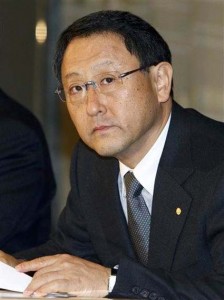In his remarks at an investor conference this morning, Akio Toyoda ignored the potential financial impact of what are the largest civil fines in U.S. history on the Japanese company he heads.
On Monday, U.S. Transportation Secretary Ray LaHood announced that the National Highway Traffic Safety Administration (NHTSA) is seeking the maximum civil penalty of $16.4 million against Toyota Motor Corporation for failing to notify the auto safety agency of what turns out to be a potentially fatal “sticky pedal” defect for at least four months. (See Toyota Broke Law! NHTSA Seeks Maximum Fines)
The Japanese company did this “despite knowing of the potential risk to consumers.” Approximately 2.3 million vehicles in the U.S. were recalled in late January for the sticky pedal defect.
“As we believe you may know, Toyota’s basic stance is to emphasize customer safety above all else and to practice rigorous quality control for this purpose.
“If, however, there are any issues we make a thorough investigation of the causes, implement countermeasures, make repairs and improvements. This is a firm and unwavering conviction that we have held since our inception,” said Toyoda.
Internal Toyota documents appear to show that Toyota attributed unintended acceleration incidents to electronics in August 2002, when it issued a Technical Service Bulletin warning that Camry models were reportedly surging out of control and recommending a fix for the electronic controls. The bulletin was also sent to the NHTSA, whichthen issued an internal memo acknowledging Toyota unintended acceleration in 2002 and 2003 Camry models. The disputed information was made public as part of Congressional hearing testimony.
The penalty being sought against Toyota would be the largest civil penalty ever assessed against an auto manufacturer by NHTSA. It is being imposed because Toyota failed to notify NHTSA after it discovered the potentially fatal safety defect in Europe and the U.S. Toyota has two weeks to contest the penalty but so far has said only that it hasn’t received the paperwork.
Critics maintain that is a laughable fine, given the billions upon billions of dollars Toyota has extracted from the U.S. market.
Executive Vice President Shinichi Sasaki cited independent quality data from both the U.S. and Germany to point out that Toyota remains among the leaders as it institutes cost cutting programs in an attempt to return to profitability.
Toyota is predicting its second consecutive fiscal year of loses. Executives spent almost all of its time emphasizing the high quality of its vehicles. Reporters were not allowed to ask questions during the presentation. ( See Toyota Posts Loss of $1.5 Billion for First Half )
For Calendar Year 2009, production dropped to 6,371,291 units of f -22.4%. Toyota says the dividend for the fiscal year ended March 31 hasn’t been decided, but reports in Japan claim it will be cut. Toyota is projecting an operating loss of 20 billion yen for the fiscal year.
Mutual opposed goals of cost cutting while spending what is independently estimated at up to $2,300 per vehicle in the U.S. during March for sales incentives are hurting the efforts to increase returns at the ailing Japanese giant.
It is unknown how long incentive costs will be at what are elevated levels for Toyota as incentives continued into April. Toyota puts the incentive costs at $400-$500 per vehicle above an unspecified normal level. (See Toyota Sales Surge! Outsells Ford, Just Lags GM)
Moreover, the eventual cost of numerous safety recalls, and what will be years of expensive litigation in the U.S. will materially affect the bottom line. The company faces hundreds of lawsuits in the U.S., including more than 50 individual suits alleging injuries or deaths caused by sudden acceleration. Toyota refuses to disclose the cost of recalls, but industry observers put the number at billions of dollars.
There will also be redesign costs, likely incurred by other automakers as well, to add or modify safety systems when the National Academy of Sciences completes its review of automotive electronic and brake override systems for NHTSA.

